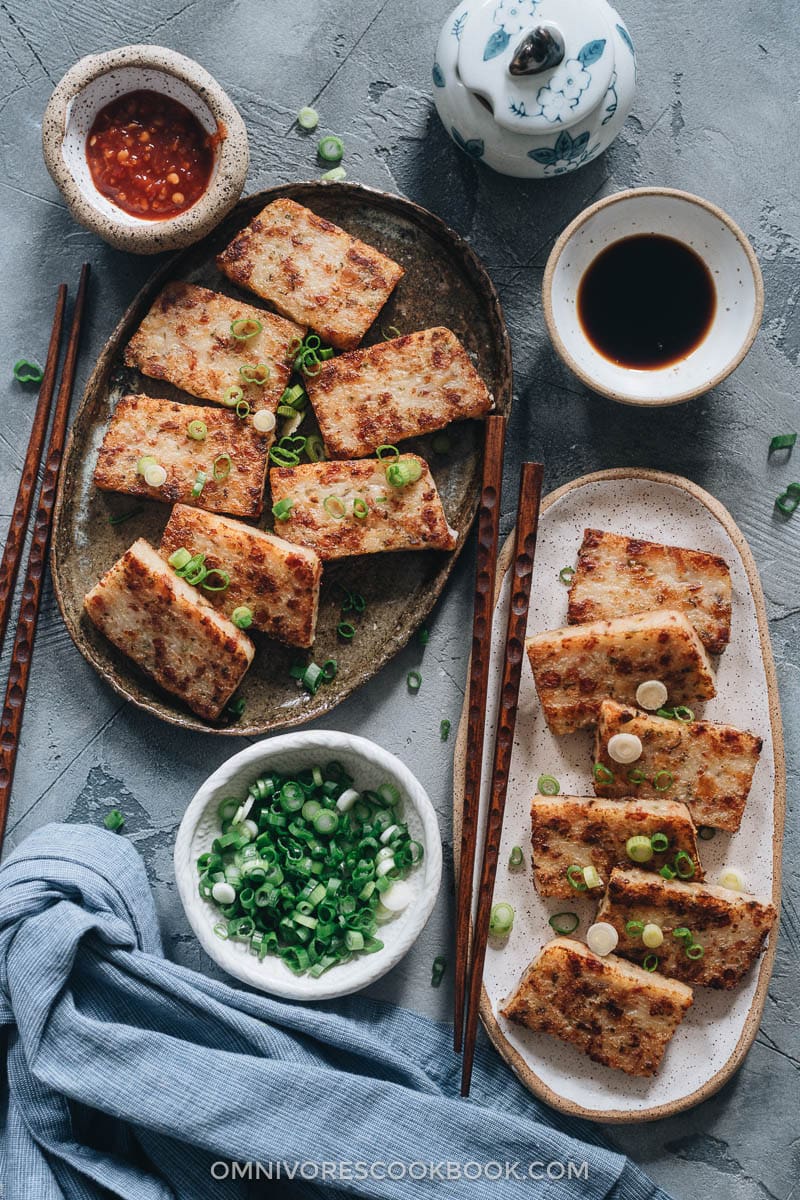
The Chinese turnip cake is a popular dim sum item and a festive dish for Chinese holidays, including Chinese New Year. It is a savory rice cake loaded with cured meat, daikon radish, mushrooms, and dried shrimp. It’s steamed, and then pan fried to create a tender texture with a crispy crust.
The first time I tried turnip cake at a dim sum restaurant, I wasn’t very impressed. You see, restaurants tend to skimp on ingredients. That rice cake contained barely any meat. It just tasted like a silky-textured salty bread, which was kind of boring. I fell in love with this dim sum dish once I tried the homemade version. Oh my, it was the opposite of the restaurant version and tasted SO GOOD!
I’ve updated the recipe with a new formula since I published it previously. I used a new approach to reduce rice flour and increase the liquid, so it yields an extra tender turnip cake just like your favorite dim sum spot.
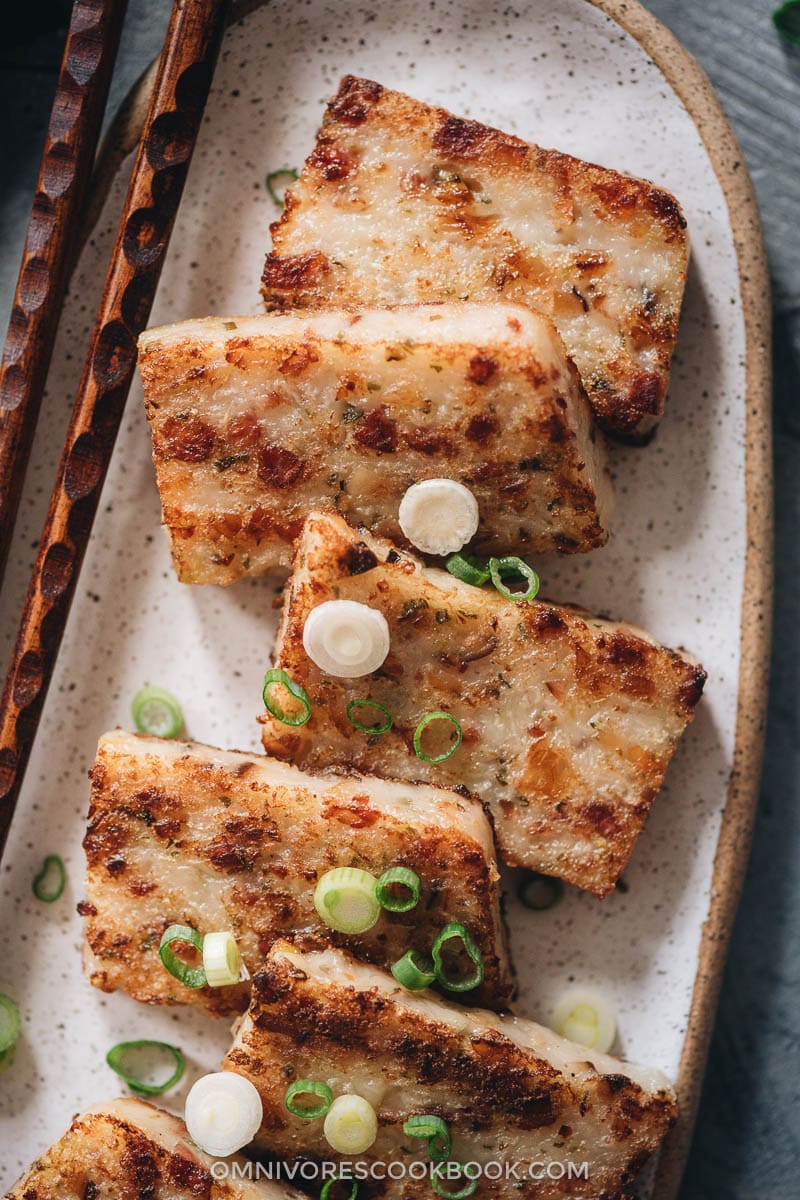
Ingredients
Key ingredients
These are the most important parts of the recipe. You might need to go to an Asian market to get them or purchase them online.
- Chinese sausage (腊肠, Lap cheong) is a type of dried sausage that’s slightly sweet. I’ve occasionally seen these at Costco and you can order them from Amazon.
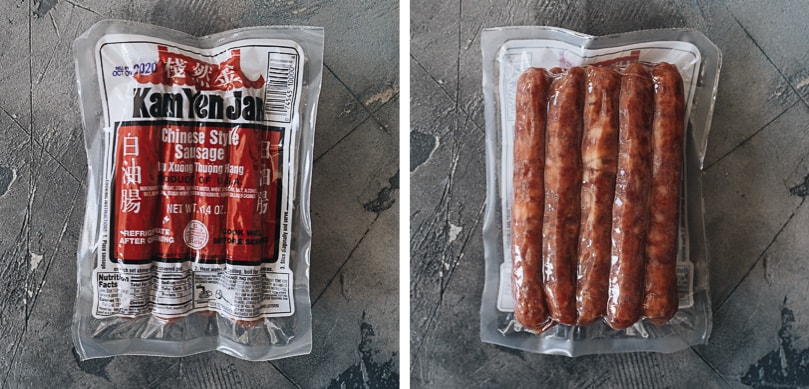
- Dried shrimp (海米, Hai Mi) are small sun-dried shrimp that have an intense sea-like flavor. You can read more about them in a previous post. I’ve seen these in grocery stores in the Mexican spices section, and you can also order them on Amazon.
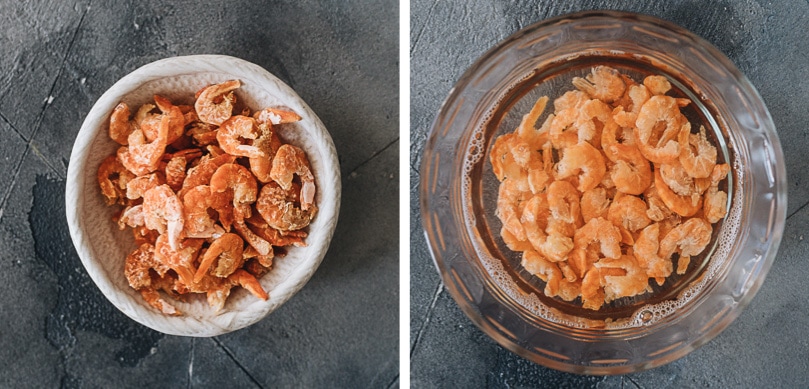
- Dried shiitake mushrooms, which add tons of umami. They are my favorite flavor enhancer. You might be able to find them at a grocery store, and certainly on Amazon.
- Daikon radish – Although the recipe is called “turnip” cake, it actually uses Chinese white radish (or daikon radish in Japan). Do not use turnip in this recipe, or else the finished dish could be off.
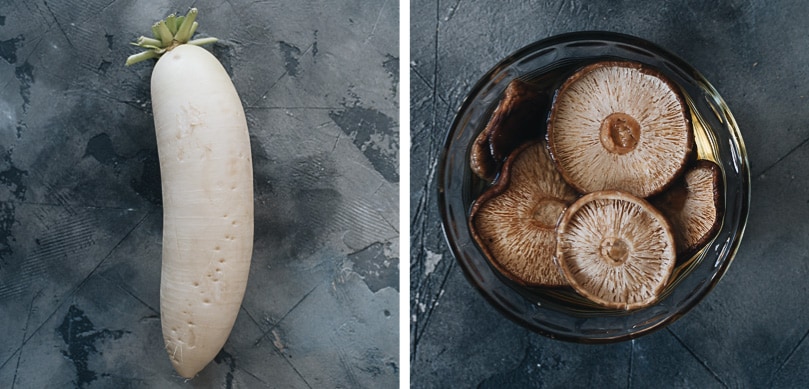
Although it’s possible to make this dish skipping one or two of these dry goods, I highly recommend you use all of them to create the best turnip cake.
How to cut Chinese sausage
It’s important to dice all the filling ingredients to small, even pieces to yield the best mouthfeel. To cut the Chinese sausage, I prefer to:
- Slice it in half
- Cut each half into thin strips
- Further chop them into small pieces

Prep work
Before cooking, your table should have:
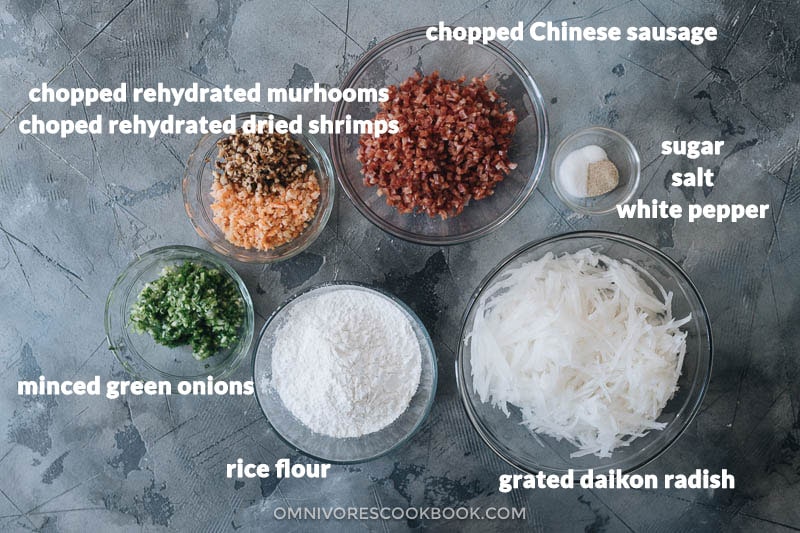
Cooking process
Cook the filling
- Brown the Chinese sausage
- Saute the dried shrimp
- Quickly cook the green onions
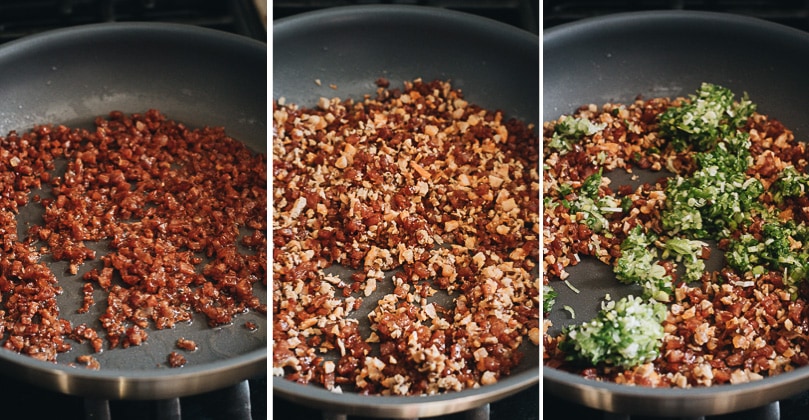
NOTE: I didn’t use any oil in this step, because Chinese sausage will render a lot of oil as it cooks. I used it to cook the rest of the ingredients, so I can use less oil in the dish.
Cook the daikon radish
- Boil the radish in a pan with water
- Drain thoroughly, then use the daikon water later in the cooking
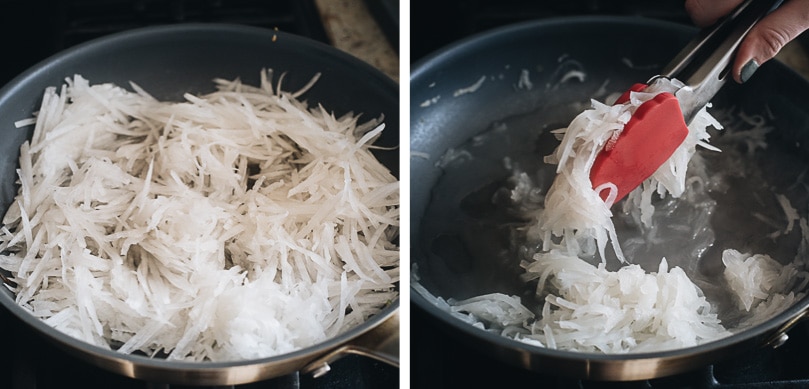
NOTE:
- I didn’t use any oil to cook the daikon, to further reduce the oil in the dish.
- It’s important to cook the daikon thoroughly, so it won’t release water in the turnip cake.
- I did one extra step by pressing the daikon and measuring the remaining liquid. This step is important to get an accurate water-flour ratio for the turnip cake.
Assemble & steam
- Mix the batter with the cooked radish and cooled daikon water.
- Cook the mixed batter in a pan.
- The mixture will thicken just enough to draw a line on the bottom of the pan.
- Add in the filling ingredients.
- Mold the cake in a tupperware container.
- Steam, then chill.
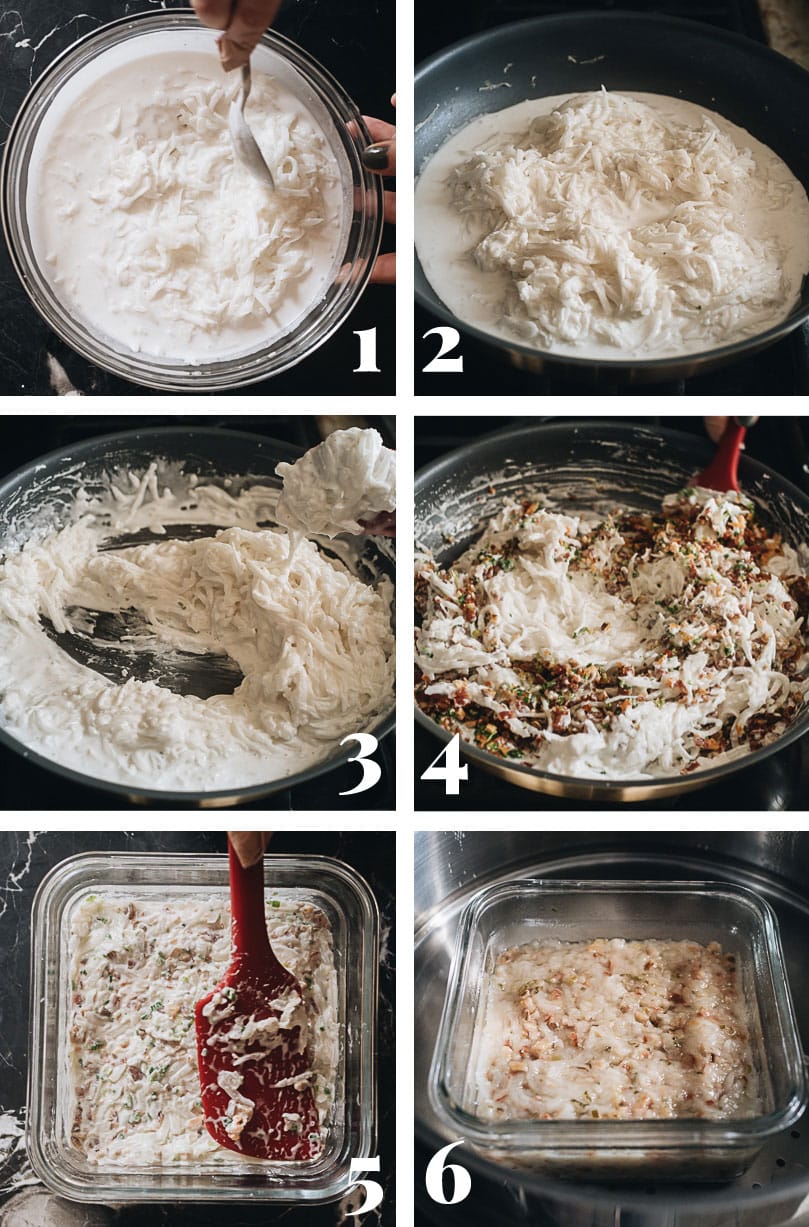
NOTE:
- You will find the batter extremely thin at first. Don’t panic! We will cook it lightly in the pan to thicken it. I’ve found that this approach is the only way to add more moisture into the turnip cake, creating an extra tender result.
- As for the steamer setup, you can use a wok on the bottom, filled with water, and a big two-layer bamboo steamer on top, to hold the cake pan. This way you can fill the turnip cake in a bigger container and cook it in one go.
- If you have a smaller steamer, you can pour the turnip cake batter into a smaller tupperware and cook in two batches.
- Rest the steamed turnip cake overnight in the fridge. I found this step very important for the recipe, because it yields a very tender cake. I tried to rest it for just two hours, but the turnip cake turned out a bit too soft and mushy after frying.
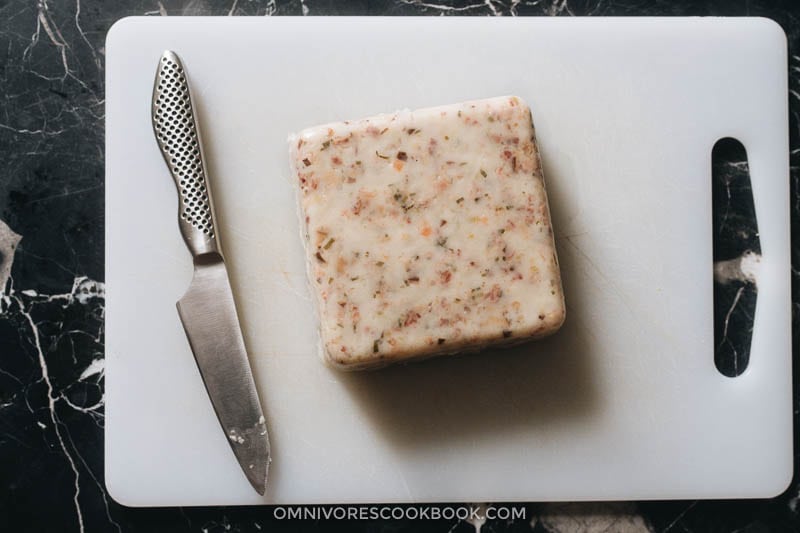

How to slice the steamed turnip cake
This recipe creates such an amazingly tender result that it can be tricky to slice the turnip cake without crushing it. I found that the best practice is to slice it with a sawing motion, so the cut edges will be smooth and clean (thus yielding an evenly browned result when pan frying).
You can see the slice on the far left is very coarse, and it was cut by pushing the knife directly downward. The rest of the pieces were cut with a sawing motion, which created smooth edges.
If you want further perfection, prepare a glass of hot water on the side. Dip your knife between each slice to rinse off the starch from the blade.
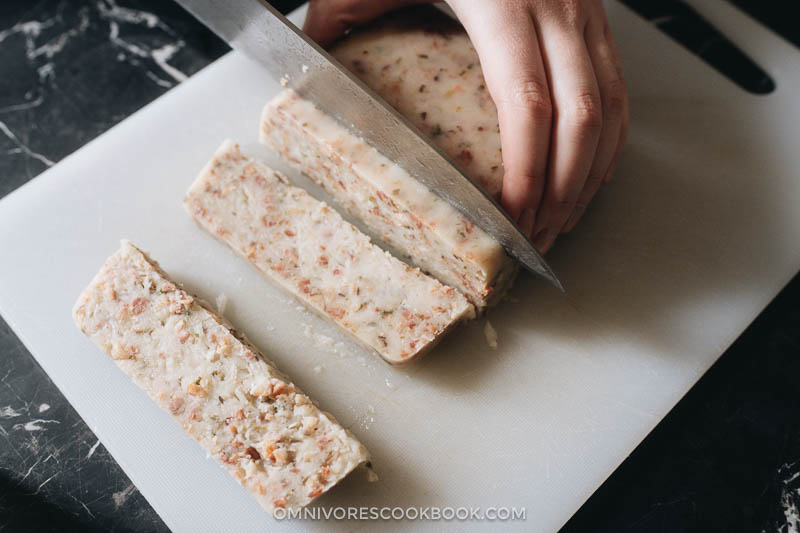
Rehat & serve
Although you can eat the turnip cakes right after cooking, I highly recommend using a bit of oil to pan fry them to create that irresistible crispy surface.
This recipe yields a very flavorful result that does not require any dipping sauce. However you can serve the cakes with hot sauce or soy sauce to give them a final boost.
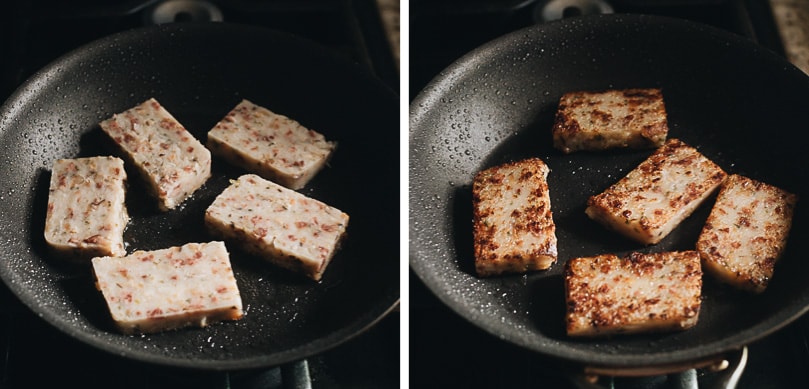
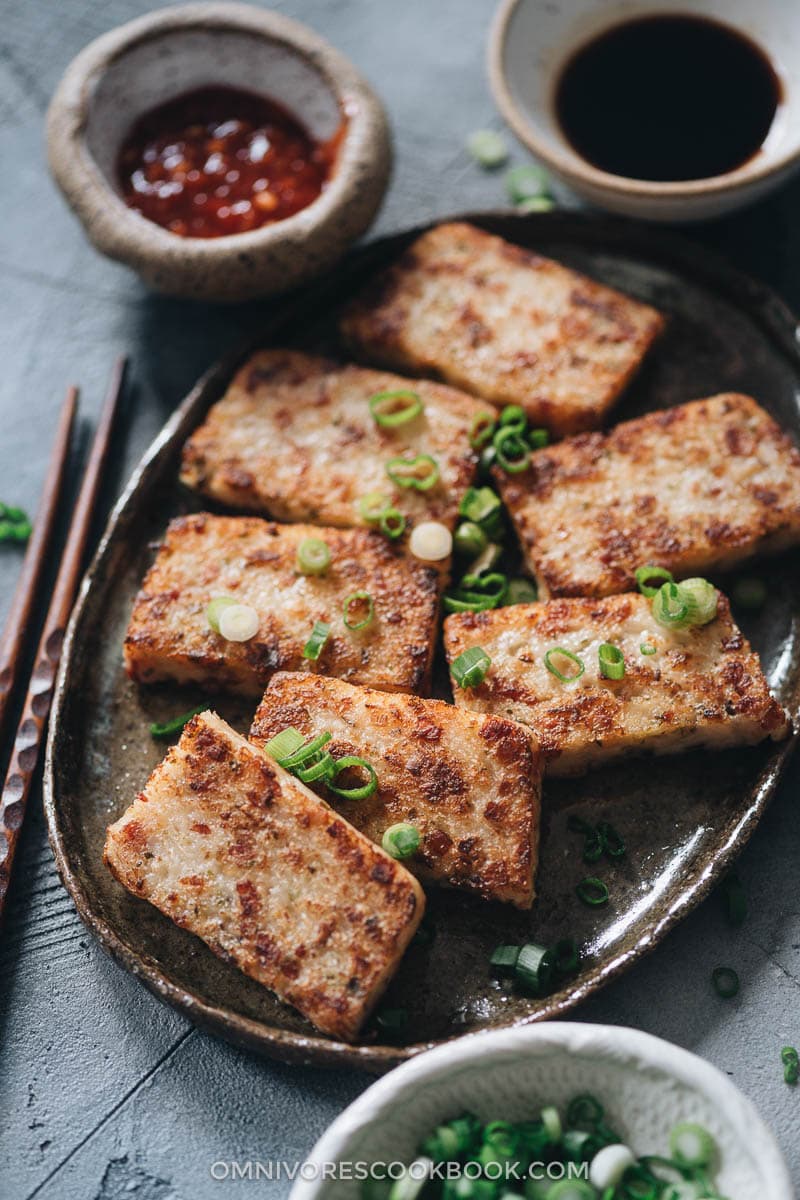
Storage
I recommend you make a full batch, because it takes about the same amount of work to cook as a half batch. Freeze some of the steamed rice cakes so you will have some awesome dim sum to snack on later!
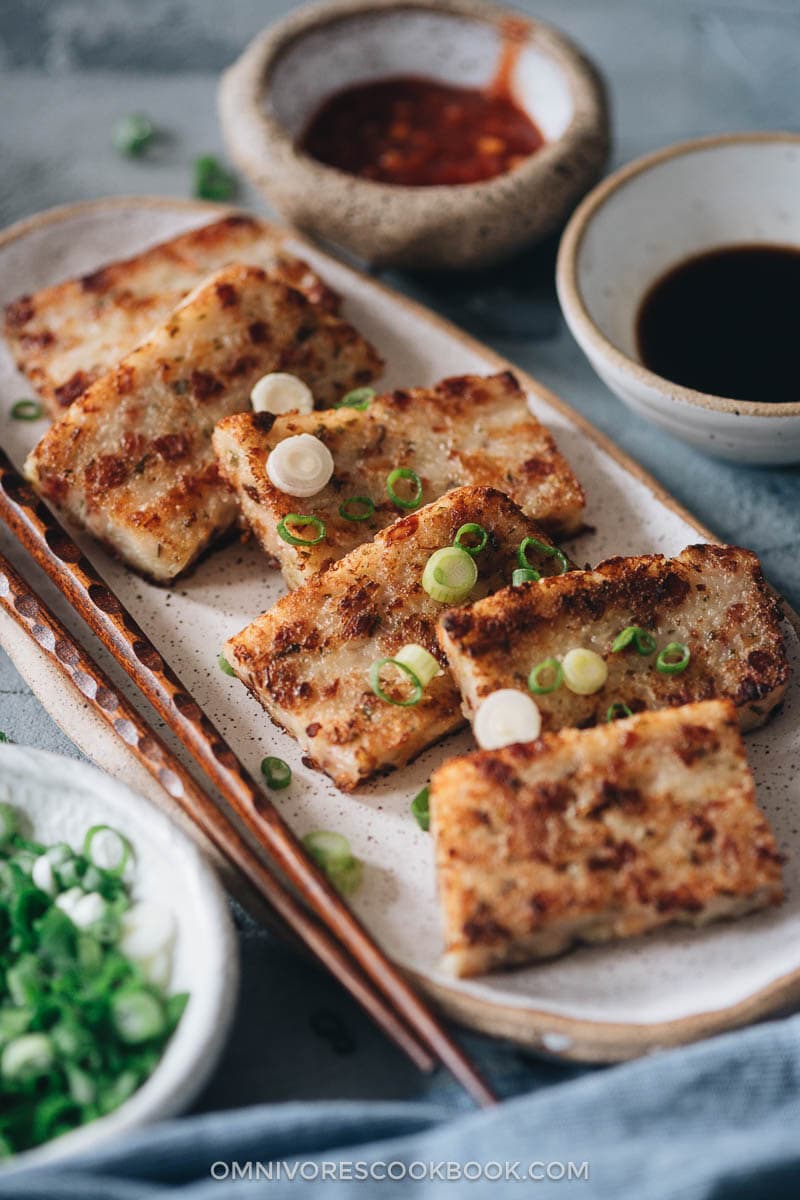
Other classic dim sum recipes
- Char Siu Bao (Steamed BBQ Pork Buns)
- Char Siu (Chinese BBQ Pork)
- How to Make Chinese Egg Rolls
- Cantonese Wonton Noodle Soup
- Chinese Steamed Custard Buns (nai wong bao)
If you give this recipe a try, let us know! Leave a comment, rate it (once you’ve tried it), and take a picture and tag it @omnivorescookbook on Instagram! I’d love to see what you come up with.
Chinese Cooking Made Easy
Are you new to this website? This free email series is a great place to start. I’ll walk you through a few of my most popular recipes and show you how and why they work. You’ll quickly start to cook better Chinese food in your own kitchen.

Chinese Turnip Cake (Lo Bak Go, 萝卜糕)
Ingredients
- 6 shiitake mushrooms
- 1/4 cup dried shrimp
- 2 lbs (900 g) daikon radish (yields 1 lb / 450 g after grating) (*Footnote 1)
- 3 (4.5 oz / 120 g) Chinese sausages , diced
- 4 green onions , chopped
- 1/4 teaspoon sugar
- 1 teaspoon salt
- 1/2 teaspoon white pepper powder
- 150 g (1 cup) rice flour
Serving options
- Soy sauce (to taste)
- Chopped green onions (Optional)
- Sriracha , or other hot sauce (Optional)
Instructions
Prep
- Rinse the shiitake mushrooms and dried shrimp separately with tap water and gently rub them to remove any dirt. Place each ingredient into a different bowl. Add hot water to cover. Soak for 15 minutes, or until the ingredients turn soft. Drain and dice into small pieces.
- Peel the daikon radish and grate it into thin strips.
Cook
- Add the Chinese sausage into a large nonstick skillet and heat it over medium heat. Cook until the sausage is lightly browned and some oil is rendered off, 5 minutes or so.
- Add the shiitake mushrooms and dried shrimp. Cook and stir for 1 minute. Add the green onions. Stir a few times to release the fragrance. Transfer everything to a plate.
- Add the daikon radish and 1 cup of water. Cover and cook over medium heat until translucent and soft but not browned, 12 minutes or so. Once done, taste the daikon to make sure it's fully cooked through and turned very soft. Transfer the cooked radish into a big bowl using a pair of tongs. Squeeze out as much juice as you can, back into the pan. Once done, transfer all the juice from the pan to a measuring cup. Then add more water until it reaches 1 cup (no need to add extra water if you end up with a full cup). Rest the liquid until it's slightly cooled, 10 to 15 minutes.
- Add rice flour and the cooled daikon cooking liquid into the bowl with the cooked radish. Add the sugar, salt, and white pepper. Stir to mix well. It will form a very runny batter.
- Pour the batter back into the pan you used to cook the radish. Cook over medium-low heat and stir constantly, until the mixture has thickened just enough to draw a line on the bottom of the pan, 1 to 2 minutes.
- Add back the cooked Chinese sausage, dried shrimp and mushrooms. Stir to mix well.
Assemble & steam
- Prepare 1 to 2 glass tupperware or baking dishes that can fit into your steamer. I used two 4.5” x 4.5” (11cm x 11 cm) glass containers to cook two batches. If you have a large wok or steamer, you might be able to fit an 8” x 8” (20cm x 20cm) baking pan in it. You’ll only need to cook one batch in this case. If you’ll be cooking in two batches, cover the uncooked batter with plastic wrap to prevent it from drying out.
- Grease the glass tupperware with oil, so the turnip cake will come off easily later. Transfer the mixture into the tupperware, about 1.5” (4 cm) thick
- Set up your steamer by adding water to the pan and bringing it to a boil. Add the steaming rack with the turnip cake container. Cook, covered, over medium-high heat, for 1 hour, until the turnip cake is cooked through. You can test the doneness by inserting a knife into the cake and it should come out clean. If your batter is slightly thicker or thinner, you might need to adjust the cooking time by adding or subtracting 10 minutes.
- Once done, remove the container from the steamer and set it aside to cool. Once the container is no longer hot, transfer it to the fridge. Let the turnip cake set until it has cooled completely. I highly recommend resting it overnight before serving. I’ve tried resting it 2 hours, and the turnip cake was a bit too soft and difficult to slice.
- To remove the fully chilled turnip cake, use a knife to loosen the edges from the container, then turn the container upside down. The turnip cake should come out in one piece.
Reheat & Serve
- To serve, cut the turnip cakes into 1/4” (1 cm) thick pieces. Brown both sides in a heated skillet coated with a thin layer of oil until heated through and the surface turns golden.
- To store, transfer the steamed turnip cakes (without pan-frying) into an airtight container and store them in the fridge for 2 to 3 days, or in the freezer for up to 1 month. To reheat, thaw the frozen turnip cakes first, and pan fry them before serving.
Notes
- I used a 2-lb (900 g) daikon radish. After peeling and grating, I had 1 lb of grated radish to use in cooking, with a small end left. You will lose quite some daikon by peeling and grating, so it’s better to purchase extra.
Nutrition

Did you make this recipe?
I’d love to hear how it turned out for you! Please take a moment to leave a 5-star rating ⭐️ and share your thoughts in the comments further down the page. It really helps others discover the recipe too.
Lilja Walter is a part of the Omnivore’s Cookbook team and worked closely with Maggie to develop and test this recipe.

Elly
I bought the wrong daikon. I did not realize there is a photo of daikon that comes with the recipe. Mine is a little green, and it turned out bitter. I bought it from Ranch99, I thought that would be the right one. Next time, I’ll pay more attention.
Andrea C.
Hello! Has anyone had success with making the batter ahead of time and then steaming the next day? Maybe best to re-warm the batter before going into the steamer? Thanks for any insight!
Ling
I tried the recipe but radish cakes turned out mushy and gooey, falls apart when I get them. Should I increase the rice flour and reduce water then? Any way of rescuing them? The flavour was amazing though. Thank you for sharing.
Maggie Zhu
I think it’s probably caused by the radish not being cooked enough to release enough liquid. The cake batter in this recipe is boardline too thin, so it will yield a super tender texture, but it does cause issues if the radish is not cooked enough. I think next time you can cook the radish a bit more, to make sure all the liquid evaporate complete. I’m afraid it’s very hard to save the batch you’ve made…
MeiMei
Better than the restaurant version, according to my husband, haha! I’ve made this twice now — the first time it was too soft, second time was perfect. SO GOOD! It is somewhat labor intensive but it’s worth it.
Erika
the first time I made this it turned out great (even though I had no shitake or shrimp haha) and I used turnip instead of real daikon but it’s a kind of turnip that has the same flavour and texture as daikon. I’ve just made it again using real daikon and the batter turned out much thicker, yet now it’s been steaming for ages and it still isn’t set. I do have shrimp this time so it smells even more delicious than last time so I really hope that with more time steaming it will set up. I’ve reread your answers to the comments here and I think the brand of rice flour and the daikon might be causing the variance. Anyway, I will persevere as it is so delicious that it’s worth keeping on experimenting to get it right.
Shirley
I have no access to the sausage or fried shrimp. What would you suggest for a substitute or could I just use the mushrooms?
Maggie Zhu
Here is a vegetarian recipe that might help: https://okonomikitchen.com/vegan-turnip-cakes-lo-bak-go/
Lin Self
Hi Maggie I just want to say your recipe is great and the lo bak go was as authentic as I remember in my childhood days. I used preserve Tai Tau Choi as well . So far the only complaint was they were given too little! Thanks very much I have also tried ma po tofu and hot and sour soup with resounding success. Thanks very much
Mike B
Thanks for updating your recipe. What was your previous ratio for rice flour to water?
Julie
The taste was perfect but I think I’d prefer it to be firmer. I steamed one pan maybe 15 minutes longer than the other and it seemed to do the trick or can I add a little more rice flour or add less liquid to achieve a firmer consistency?
Maggie Zhu
Hi Julie, thanks for leaving a positive review and I’m glad to hear you like the recipe!
I’m pretty sure you can add a big more rice flour (and / or less liquid) to achieve a firmer texture.
When developing this recipe, we decided to keep the cake very soft so it’s very similar to the ones you buy from Chinatown. But depending on how the rice flour is cooked down, the cake might end up a bit too soft.
Julie
It was very labor intensive but worth the trouble, I hope. Mine came out very mushy although I followed the recipe meticulously. Hope that increasing the steaming time will reduce the mushiness. Will refrigerate overnight and try tomorrow. Can’t wait because it looks delicious.
Elizabeth
I’ve never been a huge fan of turnip cake at dim sum, but I made this recipe as part of my Lunar New Year spread and it was SO so good. Will definitely make again. Thank you!
Elizabeth H
Where in the instructions does it have you add the mixture of sausage/mushrooms/scallions back into the daikon batter?
Maggie Zhu
Sorry for the confusion! Just added the step. You should add the cooked sausage etc to the pan with the batter and daikon after you cook it down.
Craig Zimmerman
This was fun to make and not that hard, but I found the batter a little lacking in flavor and also thought there was way about twice the sausage necessary. I’ll probably try again with more seasoning, maybe more mushroom too, sometime and cut back the sausage.
Jasmine
Just a heads up that the link you have posted for the rice flour leads to a cookie stamp for mooncakes. Otherwise, great recipe!
Emma
This recipe does not work. It comes out mushy. I left it in the fridge overnight too
Maggie
Hi Emma, I’m sorry to hear the recipe didn’t work out for you.
The turnip cake I made was on the super soft side. Depending on individual radish and how you cook it down, it might affect the result and the texture.
Chris B
yes, ours came out too mushy too. I don’t know what we did wrong….
Maggie Zhu
Hi Chris, I’m sorry to hear that your turnip cakes didn’t turn out as expected. I think it might be because the step when you cook the daikon and batter mixture, you didn’t reduce it enough. I did add a lot of liquid to the recipe, just so it creates a very tender turnip cake at the end. But the cooking part can be a bit tricky to get the consistency right.
I’ll retest the recipe soon and troubleshoot this.
happy cyclist
Yours came out beautiful. I used papery dried shrimp because that is what I had on in my fridge. I only used 1 Tbsp because I don’t like a fishy taste – just a tad bit. Mine is sitting in the fridge right now, so I hope it will come out nice tomorrow. Thanks for the recipe!
Mary
Hi Maggie,
I made your Chinese Turnip Cake today and it’s delicious! Thank you so much for your recipe. I like this version as the amount of the ingredients are not skimpy. I enjoy receiving your recipes and emails.
Sache
SACHE
March 11, 2020 at 6:44 pm
Your comment is awaiting moderation.
Thank you for such clear directions and beautiful photographs and for making “Chinese Cooking” so approachable. I appreciate the ingredient photographs in particular. We have a wonderful Chinese market and restaurant near us and I’ve felt more comfortable shopping there knowing what the ingredient I am looking for “looks like”—a picture IS worth a thousand words, particularly when I can’t read the language they are written in. Kudos to you. I continue to enjoy your posts!
(I may have posted this comment twice—the first time in the wrong place—I hope this remedies that. If I’ve muddled everything and posted twice, I will be more careful next time!)
susan
can I use chickpea flour or brown rice flour?
Sache
Thank you for such clear directions and beautiful photographs and for making “Chinese Cooking” so approachable. I appreciate the ingredient photographs in particular. We have a wonderful Chinese market and restaurant near us and I’ve felt more comfortable shopping there knowing what the ingredient I am looking for “looks like”—a picture IS worth a thousand words, particularly when I can’t read the language they are written in. Kudos to you. I continue to enjoy your posts!
Woody
Why doesn’t the recipe include turnips? I love turnips. Can you substitue turnips for daikon?
Susan Li
Daikon radish is also known as Chinese turnip, hence turnip cake. Creates a bit of confusion in English but daikon is the correct vegetable to use for this.